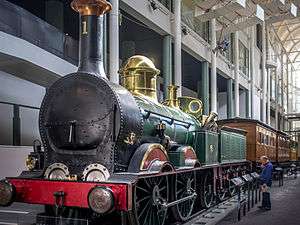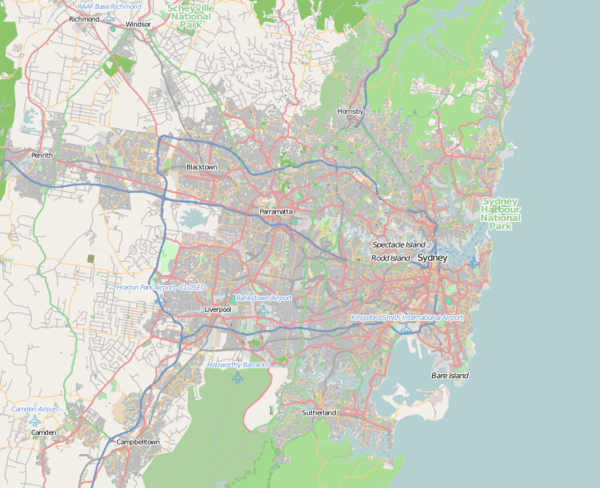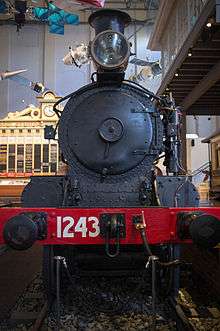Powerhouse Museum
 Locomotive No. 1 in Powerhouse Turbine Hall | |
 Location within Sydney | |
| Established | 1879 |
|---|---|
| Location | Harris Street, Ultimo, Sydney, New South Wales, Australia |
| Coordinates | 33°52′40″S 151°11′58″E / 33.877898°S 151.199573°ECoordinates: 33°52′40″S 151°11′58″E / 33.877898°S 151.199573°E |
| Type | Technology museum |
| Public transit access |
|
| Website |
powerhousemuseum |
The Powerhouse Museum is the major branch of the Museum of Applied Arts & Sciences in Sydney, the other being the historic Sydney Observatory. Although often described as a science museum, the Powerhouse has a diverse collection encompassing all sorts of technology including decorative arts, science, communication, transport, costume, furniture, media, computer technology, space technology and steam engines.
It has existed in various guises for over 125 years, and is home to some 400,000 artifacts, many of which are displayed or housed at the site it has occupied since 1988, and for which it is named — a converted electric tram power station in the Inner West suburb of Ultimo, originally constructed in 1902. It is well known, and a popular Sydney tourist destination.
In 2016, a proposal to move the Powerhouse Museum from inner Sydney Ultimo to the western Sydney district of Parramatta has proved controversial.[1]
History

The Powerhouse Museum has its origins in a recommendation of the trustees of the Australian Museum in 1878[2] and the Sydney International Exhibition of 1879 and Melbourne International Exhibition of 1880. Some exhibits from these events were kept to constitute the original collection of the new Technological, Industrial and Sanitary Museum of New South Wales.[3]
The museum was intended to be housed in the exhibition buildings known as the Garden Palace, which were destroyed by a fire in September 1882. A temporary home at the Agricultural Hall in the Domain served until relocated to new, purpose-built premises in Harris Street as the Technological Museum in August 1893. It incorporated the Sydney Observatory in 1982. The museum moved to its present location (the old Ultimo Power Station at 500 Harris Street) in March 1988, and took its present name (The Powerhouse Museum) from this new location. In February 2015, the State Government controversially announced that the museum will be relocated to Parramatta.[4][5]
Key attractions
The Powerhouse Museum houses a number of unique exhibits including the oldest operational rotative steam engine in the world, the Whitbread Engine. Dating from 1785, it is one of only a handful remaining that was built by Boulton and Watt and was acquired from Whitbread's London Brewery in 1888.[6] This engine was named a Historic Mechanical Engineering Landmark by the American Society of Mechanical Engineers in 1986.[7]
Another important exhibit is Locomotive No. 1, the first steam locomotive to haul a passenger train in New South Wales, built by Robert Stephenson in 1854.[8] The most popular exhibit is arguably "The Strasburg Clock Model", built in 1887 by a 25-year-old Sydney watchmaker named Richard Smith. It is a working model of the famous Strasbourg astronomical clock in Strasbourg Cathedral (which at that time was called Strassburg or Strasburg). Smith had never actually seen the original when he built it but worked from a pamphlet which described its timekeeping and astronomical functions.[9]
Permanent exhibitions
The museum hosts a number of permanent exhibitions, including many concerning different modes of transport and communication.
Transport

The transport exhibition looks at transport through the ages, from horse-drawn carts through steam engines, cars and planes to the latest hybrid technology. On display is Steam Locomotive No. 1243, which served for 87 years, oldest contractor built locomotive in Australia. It stands beside a mock-up of a railway platform, on the other side of which is the Governor of New South Wales's railway carriage, of the 1880s. Also in this exhibition is the original Central Railway Station destination board, relocated to the museum in the 1980s when the station was refurbished.
Powerhouse Museum restored the locomotives 3830, restored to operational order in 1997 and 3265, restored in 2009 after 40 years off the rails. Sydney's last Hansom Cab was donated to the Museum by its driver, who left it at the gates of the Harris Street building. There is also a horse-drawn bus and collection of motorbikes. Suspended aeroplanes, which can be better viewed from balconies, include the Catalina that Sir Patrick Gordon Taylor flew on the first flight from Australia to South America and in which he brought home 29 soldiers from New Guinea in 1945. There is also a Queenair Scout, the first Flying Doctor Service plane. Among the cars is a 1913 Sheffield Simplex, one of only 8 in the world. A four-minute film shows old footage of public transport.[10]
The Powerhouse Museum also has Sydney trams C11 (1898), O805 (1909), R1738 (1938. 1st of its type), steam tram motor 28A, hearse car 27s and Manly horse car 292.

The steam revolution
This exhibition is remarkable in that nearly all of the engines on display are fully operational and are regularly demonstrated working on steam power. Together with the Boulton and Watt engine, and the Museum's locomotives, steam truck and traction engines, they are a unique working collection tracing the development of steam power from the 1770s to the 1930s. Engines on display include an 1830s Maudslay engine, a Ransom and Jeffries agricultural engine and the Broken Hill Fire Brigade's horse-drawn pump-engine. The museum owns a collection of mechanical musical instruments, of which the fairground barrel organ is located in the steam exhibition, where it is powered by a small fairground engine.[11]
Space
The Space exhibition looks at space and discoveries relating to it. It includes a life size model space-shuttle cockpit. It has a feature on Australian satellites and joins the Transport exhibit through an underground temporary exhibit walkway and two side entrances.[12]
"EcoLogic": Creating a sustainable future
The "EcoLogic" exhibition focuses on the challenges facing the environment, human impact, and ways and technologies to stop this effect. There is a house setup called Ecohouse where people toggle light variables to see the outcome as well as other energy use simulators and a 'ecological footprint' game. The exhibition includes a section of a tree with a time line marked on its rings, dating back to the 17th century.[13]
Cyberworlds: computers and connections
The Cyberworlds exhibition is about computers and connections through them, and looks at the very first computing machines to the latest designs at the time of launch.[14]
"Experimentations"
"Experimentations" is a science exhibition and contains interactive displays demonstrating aspects of magnetism, light, electricity, motion and the senses. These include a machine that explains how chocolate is made and lets one taste four 'stages' of chocolate. There is a full-sized model of the front of a firetruck that measures the pedal-power used to sound its horn and lights, and a hand-powered model railway using a magnetic system to provide electric current to the track. One of the most popular features is a plasma ball that shows the electric current through the glowing gas inside it, and changes when touched.[15]
Temporary exhibitions
Australian popular culture
Various exhibitions have paid tribute to Australian popular culture. Some of these have included On the box: great moments in Australian television 1956-2006[16] tribute to 50 years of Australian television and The 80s are back[17] which looks back at life in Australia in the 1980s.
Arts
Arts oriented exhibitions have included the Fabergé exhibition, the Treasures of Palestine[18] exhibition, the "Strictly Mardi Gras" exhibition, the Christian Dior exhibition, the Audrey Hepburn exhibition, Kylie: an exhibition – a tribute to Kylie Minogue and her contribution to music, stage and screen, featuring many of her costumes. An exhibition about Diana, Princess of Wales, called Diana: a celebration[19] included items from the collection at her ancestral home, Althorp, including her wedding gown, family jewellery and movies of Diana as a child.
A Harry Potter: The Exhibition began on 19 November 2011. This exhibition has real costumes and sets from the 8 Harry Potter movies including the golden snitch, Nimbus 2000 and the Firebolt broomsticks, and various artefacts from all of the main characters. It was a massive attraction and had to be extended. The exhibition closed on 9 April 2012.
Celebrating the 20th anniversary of The Wiggles, The Wiggles' General Manager, Paul Field and Powerhouse Museum curator, Peter Cox created "The Wiggles Exhibition" and the exhibition opened in 2011 and was originally supposed to close in late 2013, however the exhibition has been renewed as one of the 'permanent exhibitions' of the Powerhouse Museum. The exhibition exhibits Wiggles memorabilia and merchandise, alongside some of The Cockroaches memorabilia, due to the fact that Anthony and Jeff were part of The Cockroaches before The Wiggles. The exhibition also features Wiggles costumes (for example, old skivvies) and props and items used in videos (for example, Jeff Wiggle puppet from various videos and TV episodes). There are also activities young children can enjoy such as, interactive painting, dancing, making roses and having a ride on the Big Red Car.
Cinema themed
Since 1988 the Powerhouse has hosted a number of large temporary exhibitions, including ones based on popular cinema franchises such as Star Trek, The Lord of the Rings,[20] and the Star Wars: Where Science Meets Imagination[21] exhibition, showing models, props and costumes from all six Star Wars films, together with recent advances in technology that are turning fantasy into reality.
Powerhouse Discovery Centre
.jpg)
Ninety five percent of the Powerhouse Museum's collection is maintained in storage at any one time. Sixty percent of this was moved from late 2004 to a new three hectare site in the northwestern Sydney suburb of Castle Hill. Built at a cost of A$12 million, this facility consists of seven huge sheds, including one the size of an aircraft hangar, within which are housed such recently rediscovered artifacts as a section of the mast of HMS Victory, Nelson's flagship at the Battle of Trafalgar, and the spare wheel from Bluebird, the car Donald Campbell drove to break the world land speed record on Lake Eyre in the 1960s. The Powerhouse Discovery Centre at Castle Hill opened to the general public on 10 March 2006.
Merz Telescope
The Powerhouse Museum has a 7 1⁄2-inch Merz Telescope that was manufactured in 1860-1861.[22]
References
- ↑ Taylor, Andrew (19 February 2016). "Culture wars: Powerhouse debate pits east against west". The Syney Morning Herald. Retrieved 20 February 2016.
- ↑ "TECHNOLOGICAL MUSEUMS AND INSTRUCTION.". The Sydney Morning Herald. National Library of Australia. 29 September 1880. p. 8. Retrieved 10 September 2013.
- ↑ "The TECHNOLOGICAL, INDUSTRIAL, and SANITARY MUSEUM.". The Sydney Morning Herald. National Library of Australia. 22 October 1880. p. 3. Retrieved 10 September 2013.
- ↑ Fitzgerald, Deborah (26 November 2014). "Powerhouse Museum to move to Parramatta". Parramatta Advertiser. Retrieved 2 December 2014.
- ↑ "NSW election 2015: Sydney's Powerhouse Museum to move to Parramatta under Coalition plan". ABC News. Australia. 26 February 2015.
- ↑ "The Boulton and Watt engine". Exhibitions. Powerhouse Museum. Retrieved 14 March 2009.
- ↑ "Boulton & Watt Rotative Steam Engine (1785)". Landmarks. American Society of Mechanical Engineers. Retrieved 19 January 2009.
- ↑ "Locomotive No. 1". Exhibitions. Powerhouse Museum. Retrieved 14 March 2009.
- ↑ "Strasburg Clock". Exhibitions. Powerhouse Museum. Retrieved 14 March 2009.
- ↑ "Transport". Exhibitions. Powerhouse Museum. Retrieved 14 March 2009.
- ↑ "The steam revolution". Exhibitions. Powerhouse Museum. Retrieved 14 March 2009.
- ↑ "Space". Exhibitions. Powerhouse Museum. Retrieved 14 March 2009.
- ↑ "Ecologic: Creating a sustainable future". Exhibitions. Powerhouse Museum. Retrieved 14 March 2009.
- ↑ "Cyberworlds: computers and connections". Exhibitions. Powerhouse Museum. Retrieved 14 March 2009.
- ↑ "Experimentations". Exhibitions. Powerhouse Museum. Retrieved 14 March 2009.
- ↑ "On the box: great moments in Australian television 1956–2006". Powerhousemuseum.com. Retrieved 2014-03-12.
- ↑ "The 80s Are Back – ended on 27 March 2011". Powerhouse Museum. 27 March 2011. Retrieved 12 March 2014.
- ↑ "Treasures of Palestine". Exhibitions. Powerhouse Museum. Retrieved 14 March 2009.
- ↑ "Diana: A Celebration – exhibition open 29 September 2007 to 4 May 2008 – Sydney, Australia". Powerhouse Museum. Retrieved 12 March 2014.
- ↑ "The Lord of the Rings Motion Picture Trilogy". Exhibitions. Powerhouse Museum. Retrieved 14 March 2009.
- ↑ "Star Wars: Where Science Meets Imagination | closed on 26 April 2009". Exhibitions. Powerhouse Museum. Retrieved 14 March 2009.
- ↑ "The Powerhouse Museum has a 7 1/2 inch Merz Telescope that was manufactured in 1860-1861" (PDF). Exhibitions. Powerhouse Museum. Retrieved 14 March 2009.
Further reading
- "Treasure Trove: 125 Years of the Powerhouse Museum" by Steve Meacham, Sydney Morning Herald (Spectrum), 18–19 September 2004, pp 1–4
- Davison, Graeme; Webber, Kimberley (2005). Yesterday's Tomorrows. Powerhouse Publishing. ISBN 0-86840-985-5.
- Museum of Applied Arts and Science Annual Report
External links
| Wikimedia Commons has media related to Powerhouse Museum. |
- Official website
- Powerhouse Discovery Centre (Castle Hill) official website
- Sydney Observatory official website
- Museum of Applied Arts and Sciences at Google Cultural Institute